A Comprehensive Study on The Accelerated Weathering Properties of Polypropylene—Wood Composites with Non-Metallic Materials of Waste-Printed Circuit Board Powders
Abstract
:1. Introduction
2. Experimental
2.1. Raw Materials
2.2. Experimental Procedure
2.2.1. Preparation of Various PP Composites
2.2.2. UV-Accelerated Weathering
2.3. Testing and Characterization
2.3.1. Oxidation Induction Time (OIT)
2.3.2. Mechanical Properties
2.3.3. Optical Microscope (OM)
2.3.4. Fourier-Transform Infrared (FTIR)
2.3.5. Differential Scanning Calorimetry (DSC)
2.3.6. Vicat Softening Point Analysis
2.3.7. Scanning Electron Microscopy (SEM)
3. Results and Discussion
3.1. OIT Values
3.2. Mechanical Properties
3.3. Visual Appearance
3.4. Surface Chemistry
3.5. Morphology of the Fractured Surface
3.6. DSC Analysis
3.7. Vicat Softening Temperature Analysis
4. Conclusions
Author Contributions
Funding
Conflicts of Interest
References
- Breivik, K.; Armitage, J.M.; Wania, F.; Sweetman, A.J.; Jones, K.C. Tracking the global distribution of Persistent Organic Pollutants accounting for e-waste exports to developing regions. Environ. Sci. Technol. 2015, 50, 798–805. [Google Scholar] [CrossRef] [PubMed] [Green Version]
- Cesaro, A.; Marra, A.; Belgiorno, V.; Guida, M. Effectiveness of WEEE mechanical treatment: Separation yields and recovered material toxicity. J. Clean. Prod. 2017, 142, 2656–2662. [Google Scholar] [CrossRef]
- Yousef, S.; Tatariants, M.; Tichonovas, M.; Bendikiene, R.; Denafas, G. Recycling of bare waste printed circuit boards as received using an organic solvent technique at a low temperature. J. Clean. Prod. 2018, 187, 780–788. [Google Scholar] [CrossRef]
- Verma, H.R.; Singh, K.K.; Mankhand, T.R. Delamination mechanism study of large size waste printed circuit boards by using dimethylacetamide. Waste Manag. 2017, 65, 139–146. [Google Scholar] [CrossRef] [PubMed]
- Zlamparet, G.I.; Zeng, X.; Awasthi, A.K.; Li, J. Evaluating waste printed circuit boards recycling: Opportunities and challenges, a mini review. Waste Manag. Res. 2017, 35, 346–356. [Google Scholar]
- Zeng, X.; Li, J. Measuring the recyclability of e-waste: an innovative method and its implications. J. Clean. Prod. 2016, 131, 156–162. [Google Scholar] [CrossRef]
- Ikhlayel, M. Environmental impacts and benefits of state-of-the-art technologies for E-waste management. Waste Manag. 2017, 68, 458–474. [Google Scholar] [CrossRef] [PubMed]
- Tian, S.; He, H.; Yu, P.; Zhou, L.; Luo, Y.; Jia, D. Sustainable utilization of waste printed circuit boards powders in HDPE-wood composites: Synergistic effects of multicomponents on structure and properties. J. Clean. Prod. 2017, 164, 840–847. [Google Scholar] [CrossRef]
- Yang, S.; Bai, S.; Wang, Q. Morphology, mechanical and thermal oxidative aging properties of HDPE composites reinforced by nonmetals recycled from waste printed circuit boards. Waste Manag. 2016, 57, 168–175. [Google Scholar] [CrossRef] [PubMed]
- Kumar, A.; Choudhary, V.; Khanna, R.; Tripathi, S.N.; Ikram-Ul-Haq, M.; Sahajwalla, V. Structural, thermal, morphological and dynamic mechanical characteristics of waste-reinforced polypropylene composites: A novel approach for recycling electronic waste. J. Appl. Polym. Sci. 2016, 133, 43389. [Google Scholar] [CrossRef]
- Hadi, P.; Ning, C.; Ouyang, W.; Xu, M.; Lin, C.S.K.; McKay, G. Toward environmentally-benign utilization of nonmetallic fraction of waste printed circuit boards as modifier and precursor. Waste Manag. 2015, 35, 236–246. [Google Scholar] [CrossRef] [PubMed]
- Pan, Y.-T.; Wang, D.-Y. Fabrication of low-fire-hazard flexible poly (vinyl chloride) via reutilization of heavy metal biosorbents. J. Hazard. Mater. 2017, 339, 143–153. [Google Scholar] [CrossRef] [PubMed]
- Hu, D.; Jia, Z.; Li, J.; Zhong, B.; Fu, W.; Luo, Y. Characterization of Waste Printed Circuit Boards Nonmetals and its Reutilization as Reinforcing Filler in Unsaturated Polyester Resin. J. Polym. Environ. 2017, 26, 1311–1319. [Google Scholar] [CrossRef]
- Hu, D.; Jia, Z.; Zhong, B.; Lin, J.; Liu, M.; Luo, Y.; Jia, D. Method for improving the mechanical performance and thermal stability of unsaturated polyester resin/waste-printed circuit board nonmetals composites via isocyanate chemistry. J. Appl. Polym. Sci. 2017, 134, 45129. [Google Scholar] [CrossRef]
- Kovačević, T.; Rusmirović, J.; Tomić, N.; Marinović-Cincović, M.; Kamberović, Željko; Tomić, M.; Marinković, A.; Kovaevi, T.; Rusmirovi, J.; Tomi, N.; et al. New composites based on waste PET and non-metallic fraction from waste printed circuit boards: Mechanical and thermal properties. Compos. Part B Eng. 2017, 127, 1–14. [Google Scholar] [CrossRef]
- Yu, D.; Duan, H.; Song, Q.; Liu, Y.; Li, Y.; Li, J.; Shen, W.; Luo, J.; Wang, J. Characterization of brominated flame retardants from e-waste components in China. Waste Manag. 2017, 68, 498–507. [Google Scholar] [CrossRef] [PubMed]
- Bin Bahari, S.A. Wood-polymer Composites. J. Clean. Prod. 2016, 110, 194. [Google Scholar] [CrossRef]
- Quiroga, A.; Marzocchi, V.; Rintoul, I. Influence of wood treatments on mechanical properties of wood–cement composites and of Populus Euroamericana wood fibers. Compos. Part B Eng. 2016, 84, 25–32. [Google Scholar] [CrossRef]
- Torres-Giner, S.; Montanes, N.; Fenollar, O.; García-Sanoguera, D.; Balart, R. Development and optimization of renewable vinyl plastisol/wood flour composites exposed to ultraviolet radiation. Mater. Des. 2016, 108, 648–658. [Google Scholar] [CrossRef]
- Sommerhuber, P.F.; Wenker, J.L.; Rüter, S.; Krause, A. Life cycle assessment of wood-plastic composites: Analysing alternative materials and identifying an environmental sound end-of-life option. Resour. Conserv. Recycl. 2017, 117 Pt B, 235–248. [Google Scholar] [CrossRef]
- Chen, H.; Tian, S.; He, H. Mechanical, flammability, and thermal properties of polyvinyl chloride-wood composites with carbide slag. Polym. Compos. 2015, 38, 2898–2906. [Google Scholar]
- Teuber, L.; Osburg, V.-S.; Toporowski, W.; Militz, H.; Krause, A. Wood polymer composites and their contribution to cascading utilisation. J. Clean. Prod. 2016, 110, 9–15. [Google Scholar] [CrossRef]
- Muniyandi, S.K.; Sohaili, J.; Hassan, A. Accelerated weathering properties of compatibilized composites made from recycled HDPE and nonmetallic printed circuit board waste. J. Appl. Polym. Sci. 2015, 133, 43110–43121. [Google Scholar] [CrossRef]
- Schirp, A.; Su, S. Effectiveness of pre-treated wood particles and halogen-free flame retardants used in wood-plastic composites. Polym. Degrad. Stab. 2016, 126, 81–92. [Google Scholar] [CrossRef]
- Väntsi, O.; Kärki, T. Environmental assessment of recycled mineral wool and polypropylene utilized in wood polymer composites. Resour. Conserv. Recycl. 2015, 104, 38–48. [Google Scholar] [CrossRef]
- Bhat, I.-U.-H.; Khalil, H.A.; Awang, K.B.; Bakare, I.; Issam, A. Effect of weathering on physical, mechanical and morphological properties of chemically modified wood materials. Mater. Des. 2010, 31, 4363–4368. [Google Scholar] [CrossRef]
- Tatariants, M.; Yousef, S.; Denafas, G.; Bendikiene, R. Separation and purification of metal and fiberglass extracted from waste printed circuit boards using milling and dissolution techniques. Environ. Prog. Sustain. Energy 2018, 37, 2082–2092. [Google Scholar] [CrossRef]
- Azuma, Y.; Takeda, H.; Watanabe, S.; Nakatani, H. Outdoor and accelerated weathering tests for polypropylene and polypropylene/talc composites: A comparative study of their weathering behavior. Polym. Degrad. Stab. 2009, 94, 2267–2274. [Google Scholar] [CrossRef]
- Bu, J.; Huang, X.; Li, S.; Jiang, P. Significantly enhancing the thermal oxidative stability while remaining the excellent electrical insulating property of low density polyethylene by addition of antioxidant functionalized graphene oxide. Carbon 2016, 106, 218–227. [Google Scholar] [CrossRef]
- Beer, S.; Teasdale, I.; Brueggemann, O. Macromolecular antioxidants via thiol-ene polyaddition and their synergistic effects. Polym. Degrad. Stab. 2014, 110, 336–343. [Google Scholar] [CrossRef]
- Gijsman, P.; Sampers, J. Oxygen uptake measurements to identify the cause of unexpected differences between accelerated and outdoor weathering. Angew. Makromol. Chem. 1998, 261–262, 77–82. [Google Scholar] [CrossRef]
- Essabir, H.; Bensalah, M.O.; Rodrigue, D.; Bouhfid, R.; Qaiss, A.E.K. A comparison between bio- and mineral calcium carbonate on the properties of polypropylene composites. Constr. Build. Mater. 2017, 134, 549–555. [Google Scholar] [CrossRef]
- Gao, X.; Hu, G.; Qian, Z.; Ding, Y.; Zhang, S.; Wang, D.; Yang, M. Immobilization of antioxidant on nanosilica and the antioxidative behavior in low density polyethylene. Polymer 2007, 48, 7309–7315. [Google Scholar] [CrossRef]
- Kallakas, H.; Poltimäe, T.; Süld, T.-M.; Kers, J.; Krumme, A. The influence of accelerated weathering on the mechanical and physical properties of wood-plastic composites. Proc. Est. Acad. Sci. 2015, 64, 94–104. [Google Scholar] [CrossRef]
- Aldajah, S.; Al-Omari, A.; Biddah, A. Accelerated weathering effects on the mechanical and surface properties of CFRP composites. Mater. Des. 2009, 30, 833–837. [Google Scholar] [CrossRef]
- Yang, X.; Ding, X. Prediction of outdoor weathering performance of polypropylene filaments by accelerated weathering tests. Geotext. Geomembr. 2006, 24, 103–109. [Google Scholar] [CrossRef]
- Stark, N.M.; Matuana, L.M. Characterization of weathered wood–plastic composite surfaces using FTIR spectroscopy, contact angle, and XPS. Polym. Degrad. Stab. 2007, 92, 1883–1890. [Google Scholar] [CrossRef]
- Pandey, K.; Pitman, A. FTIR studies of the changes in wood chemistry following decay by brown-rot and white-rot fungi. Int. Biodeterior. Biodegrad. 2003, 52, 151–160. [Google Scholar] [CrossRef]
- Muasher, M.; Sain, M. The efficacy of photostabilizers on the color change of wood filled plastic composites. Polym. Degrad. Stab. 2006, 91, 1156–1165. [Google Scholar] [CrossRef]
- Gulmine, J.; Janissek, P.; Heise, H.; Akcelrud, L. Degradation profile of polyethylene after artificial accelerated weathering. Polym. Degrad. Stab. 2003, 79, 385–397. [Google Scholar] [CrossRef]
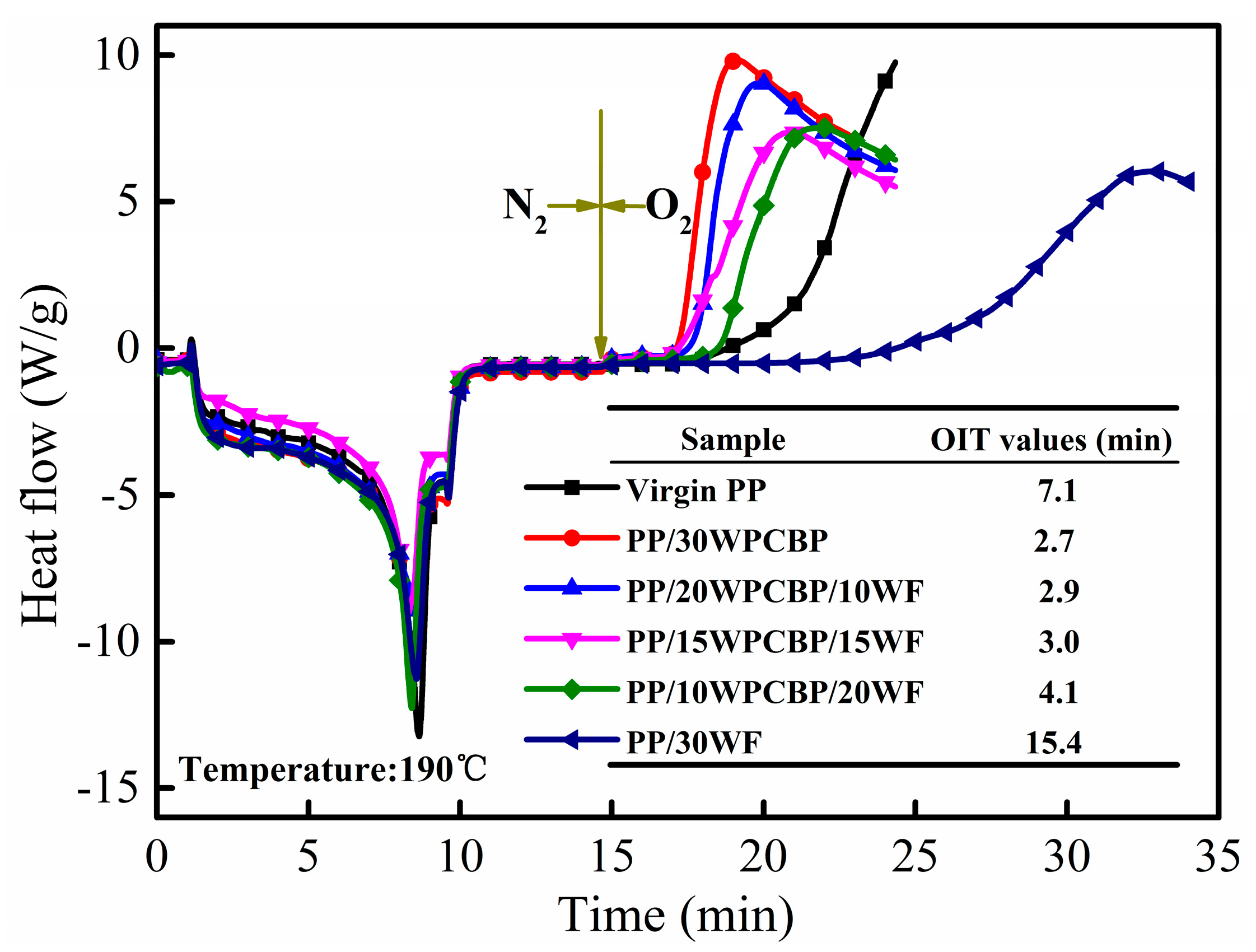
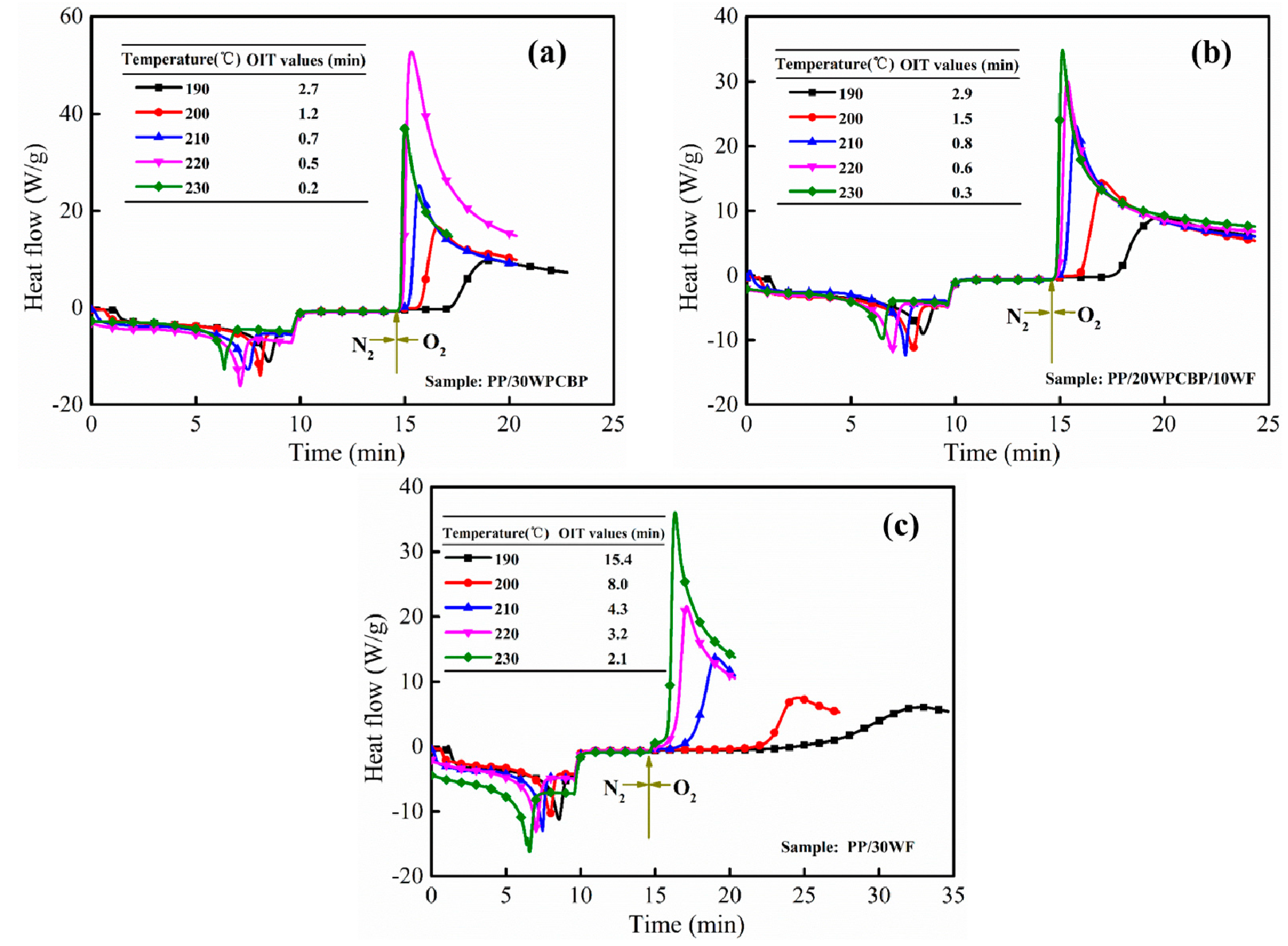
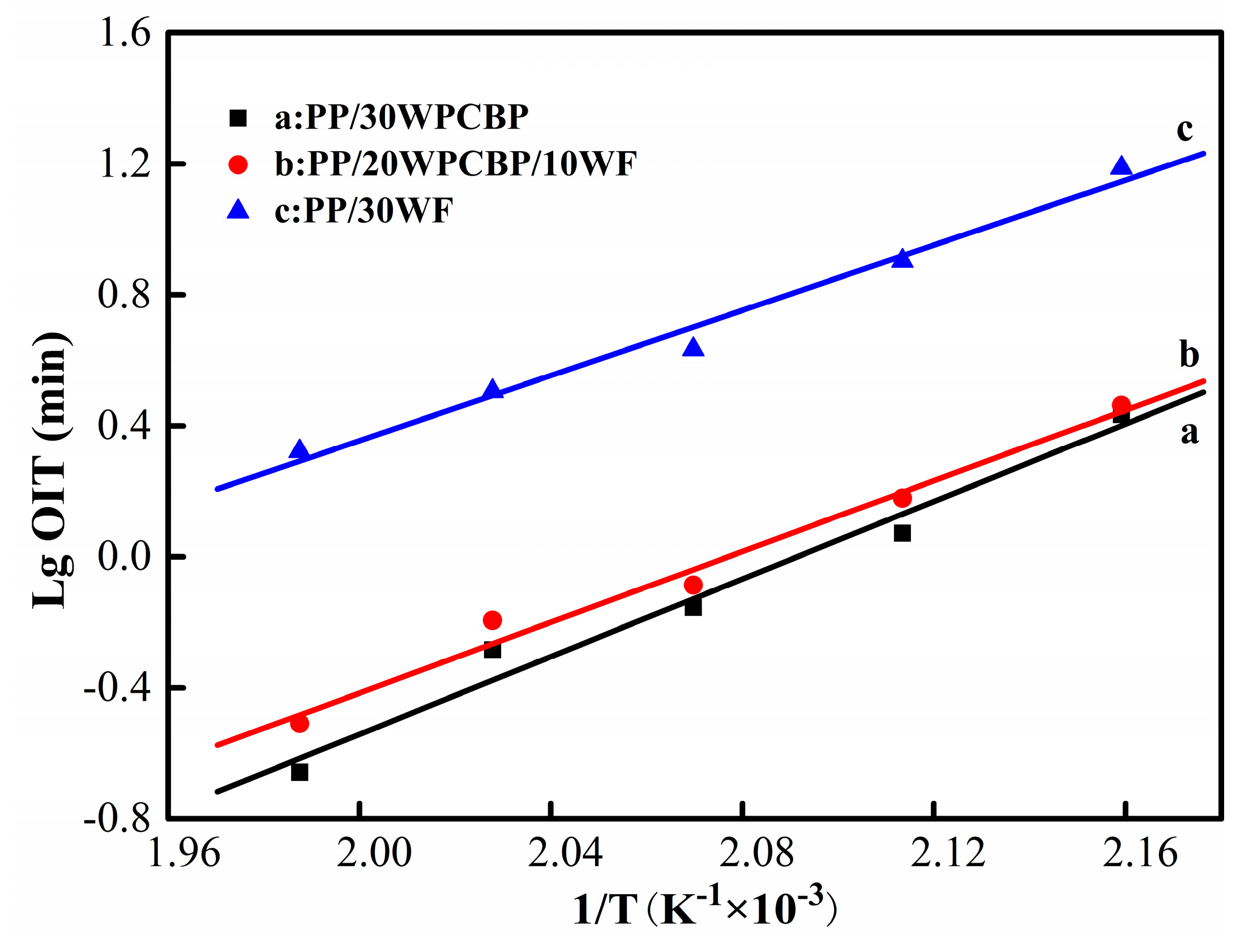
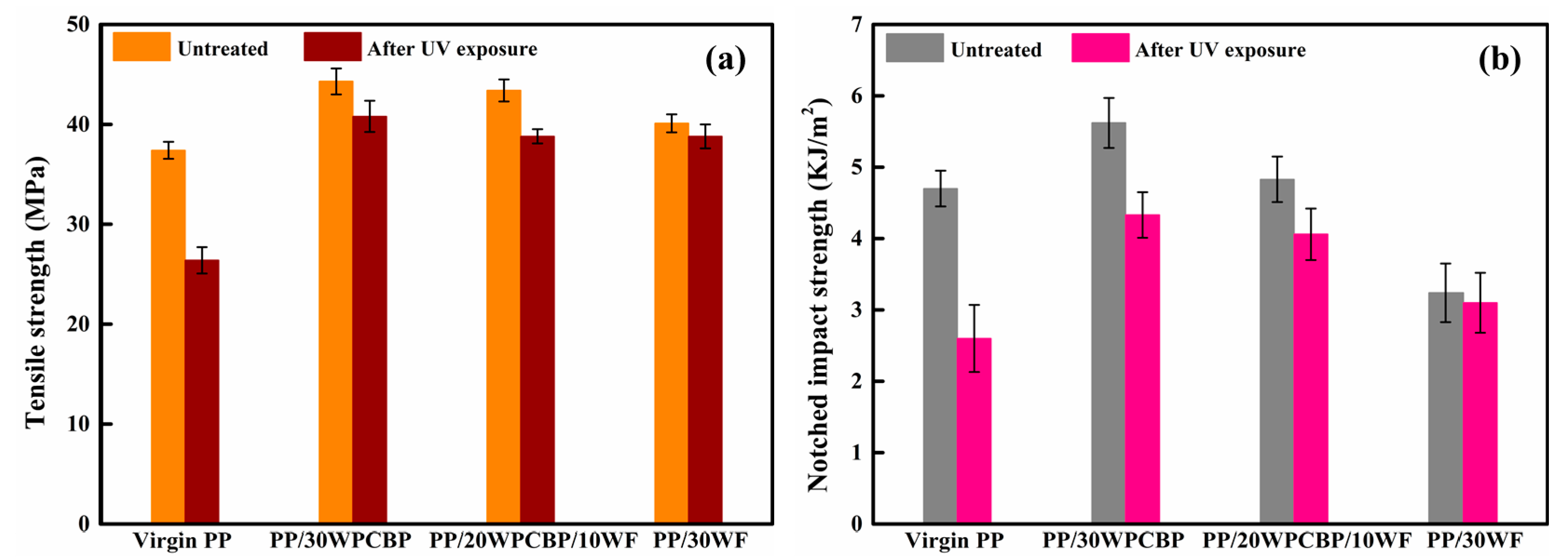
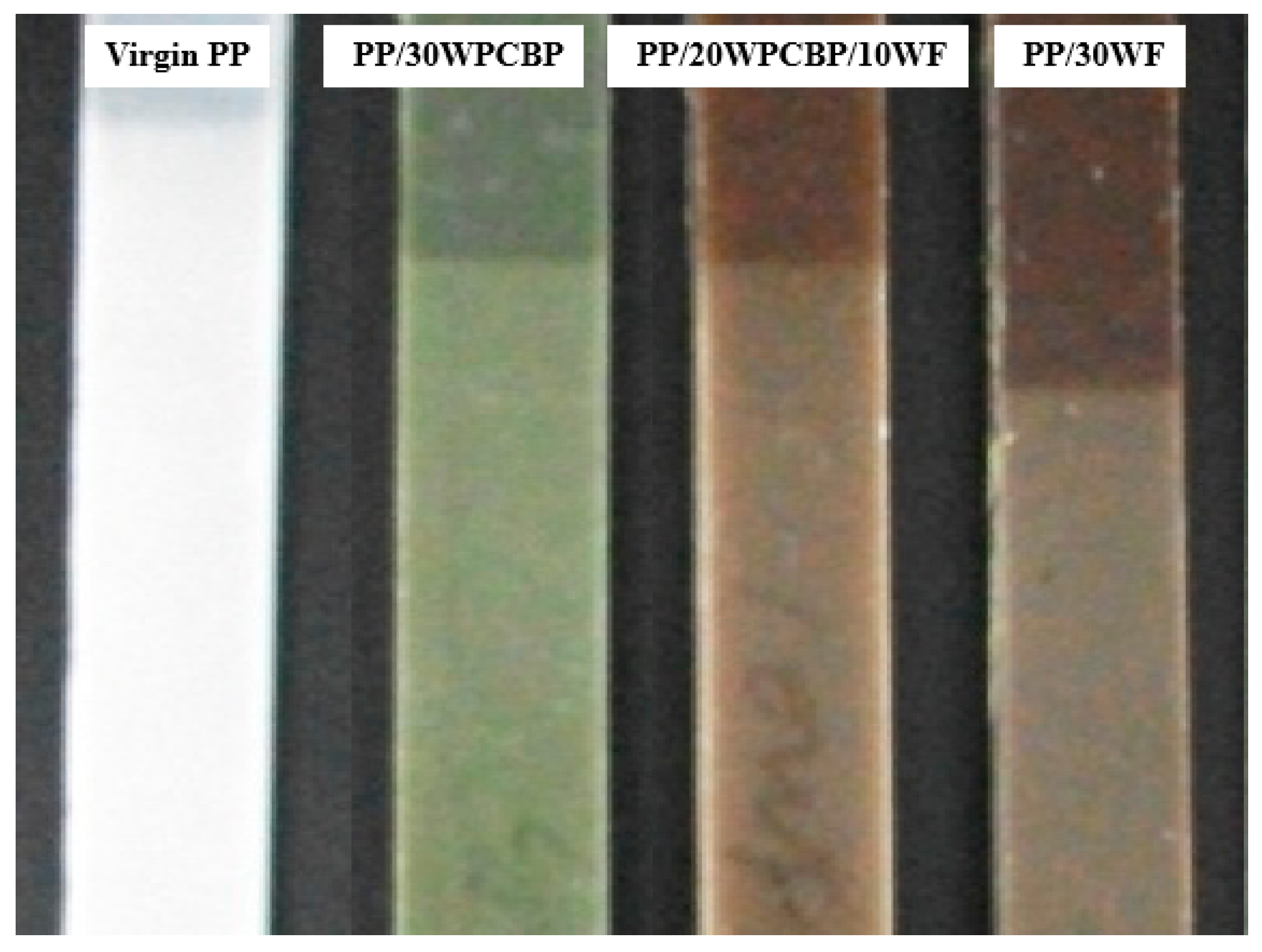
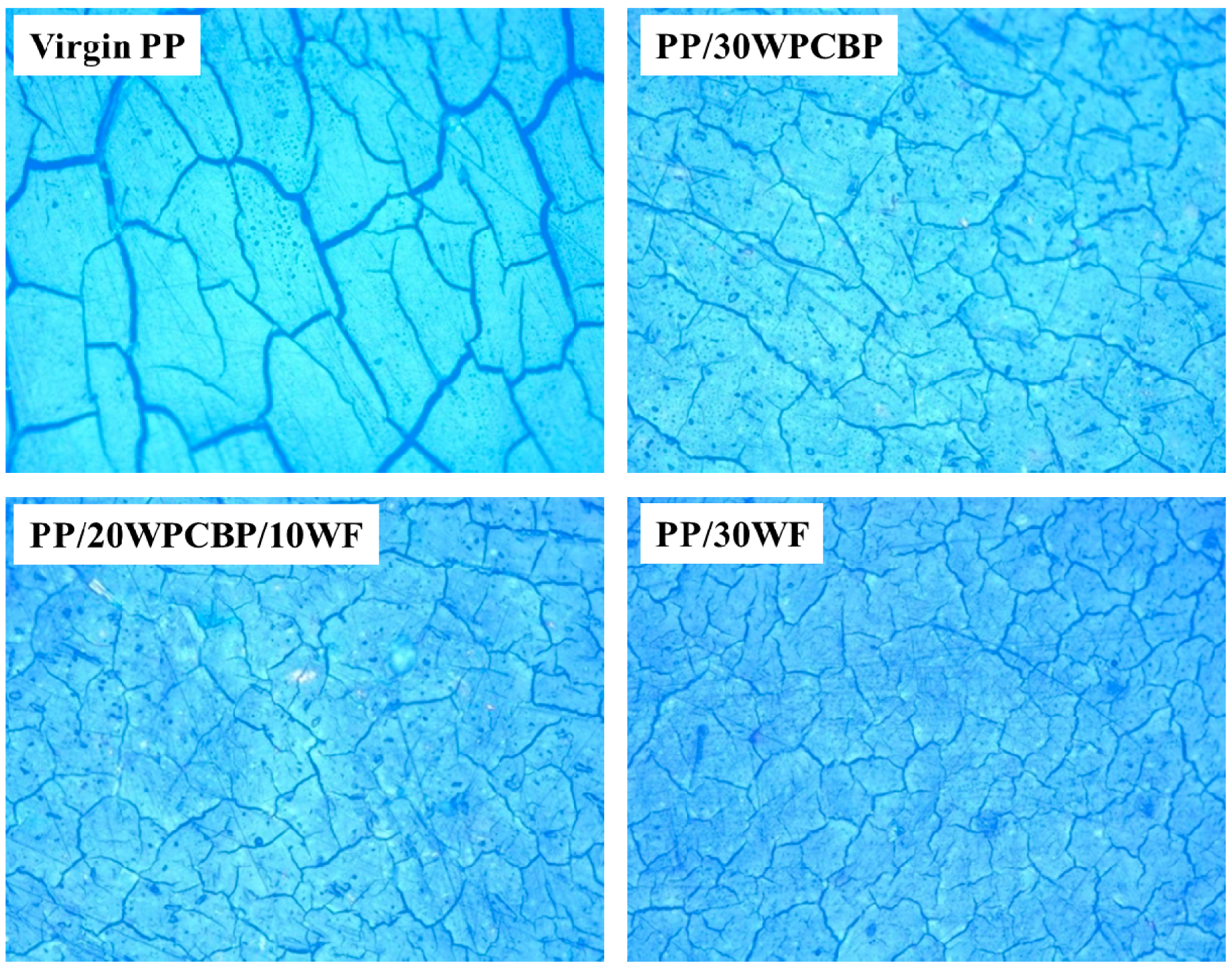
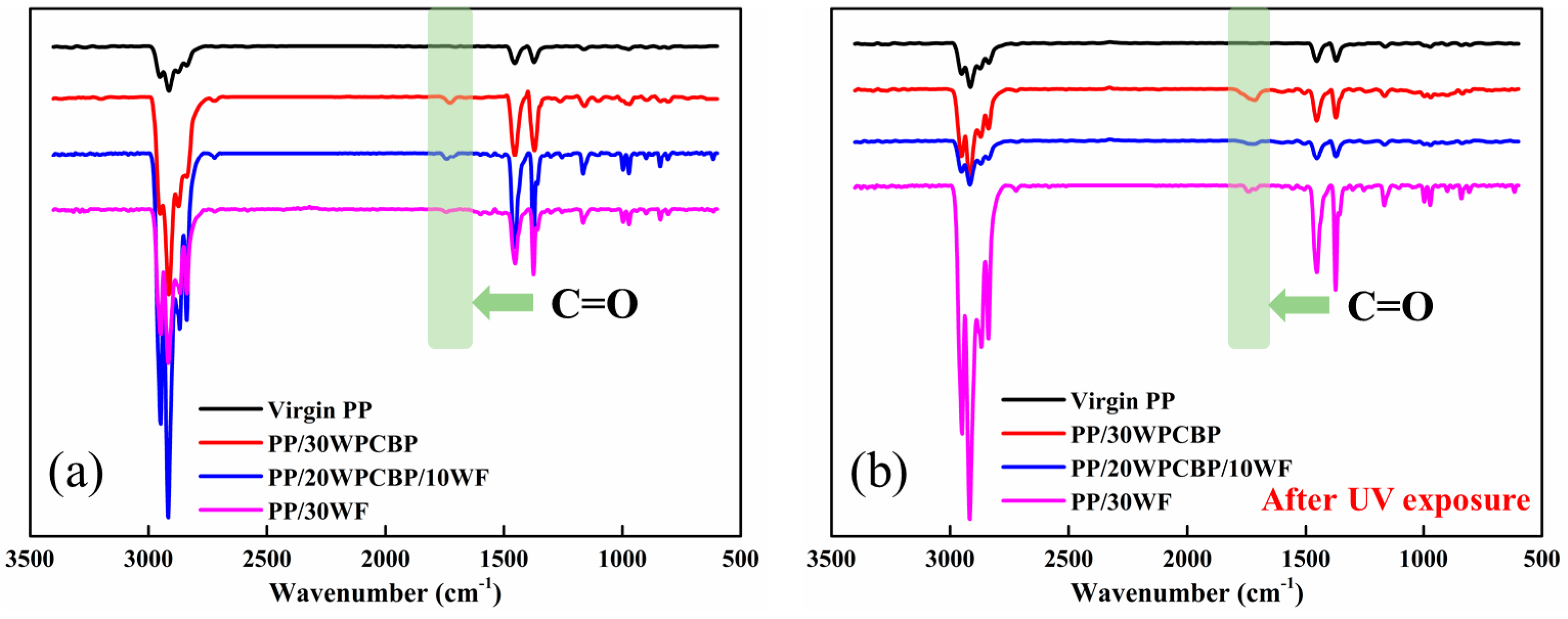
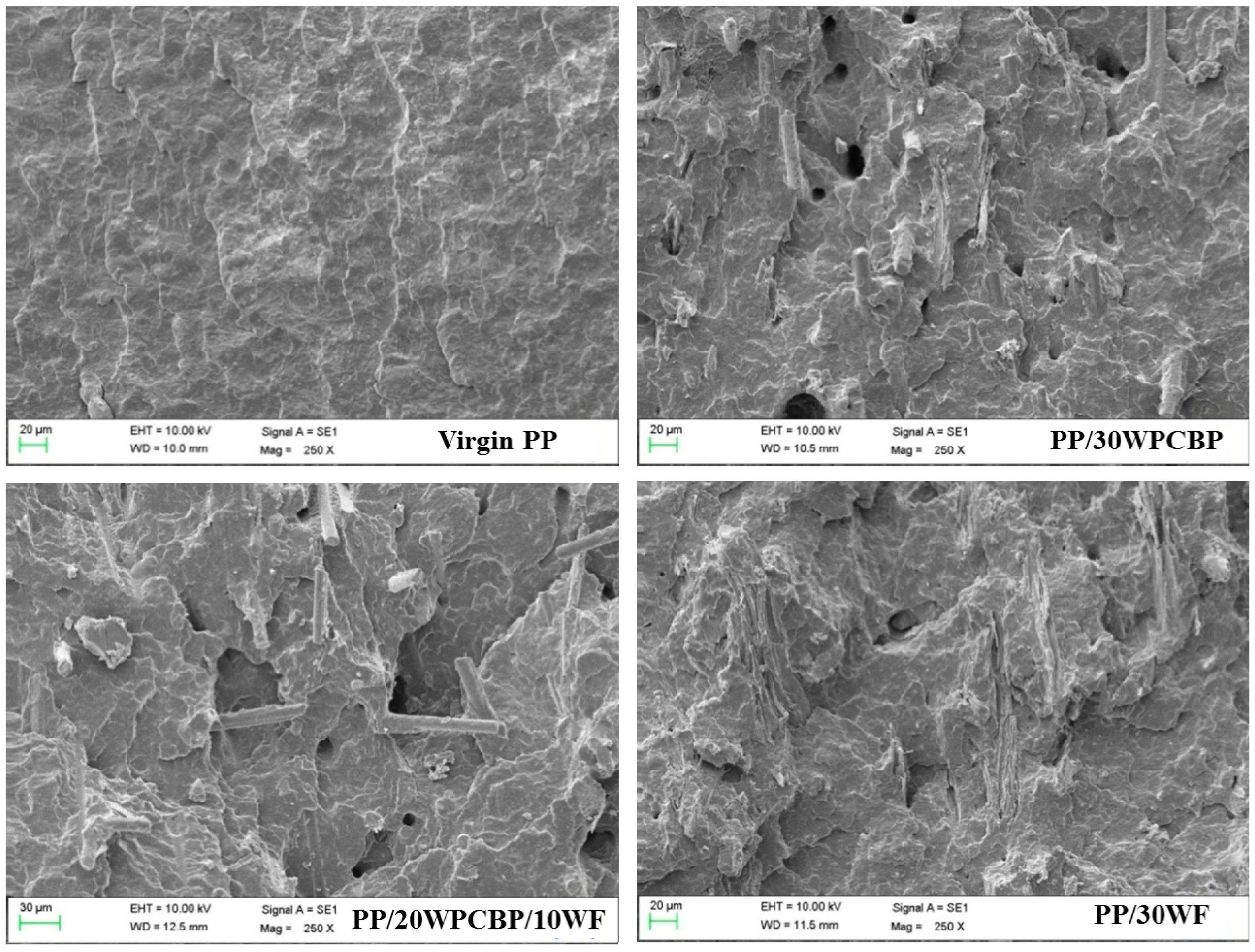
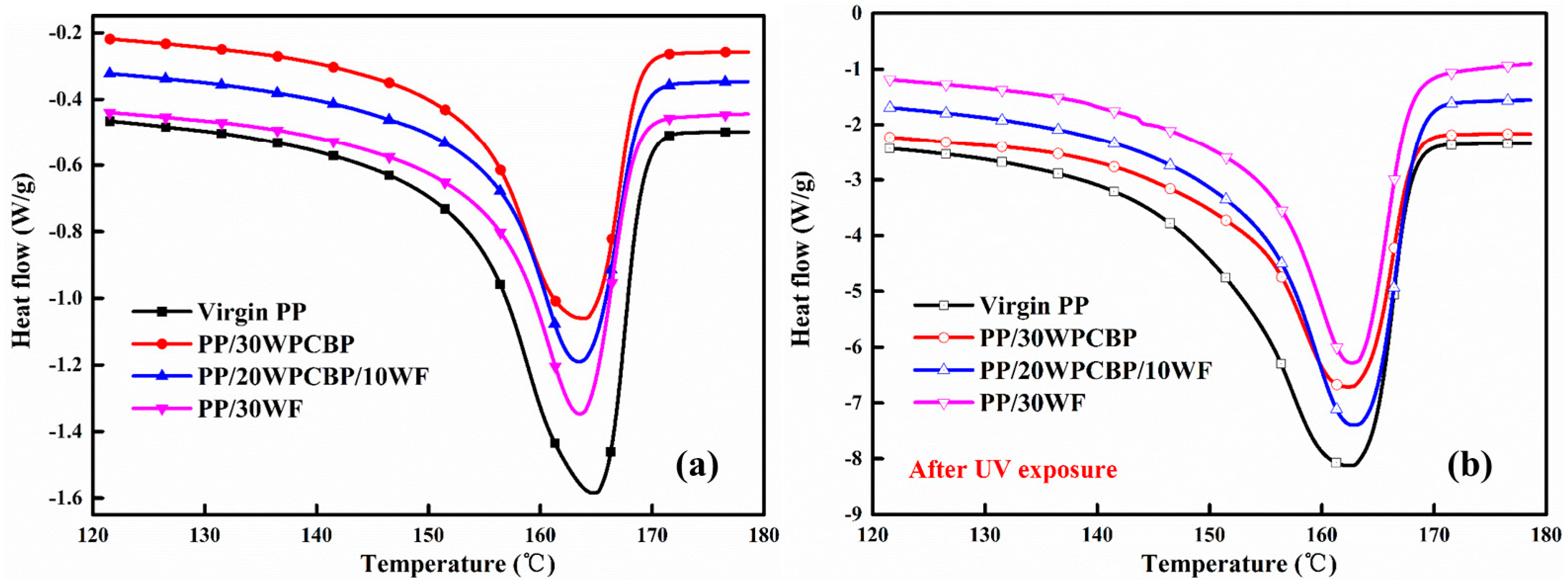
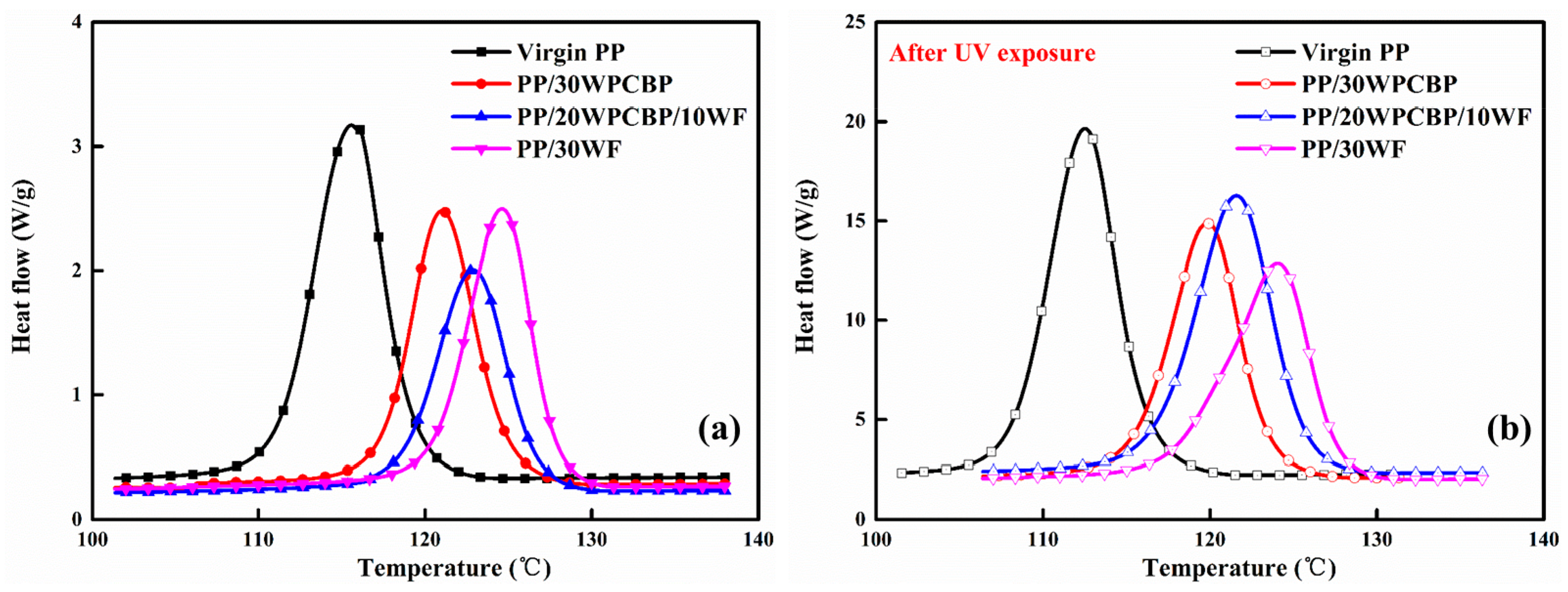
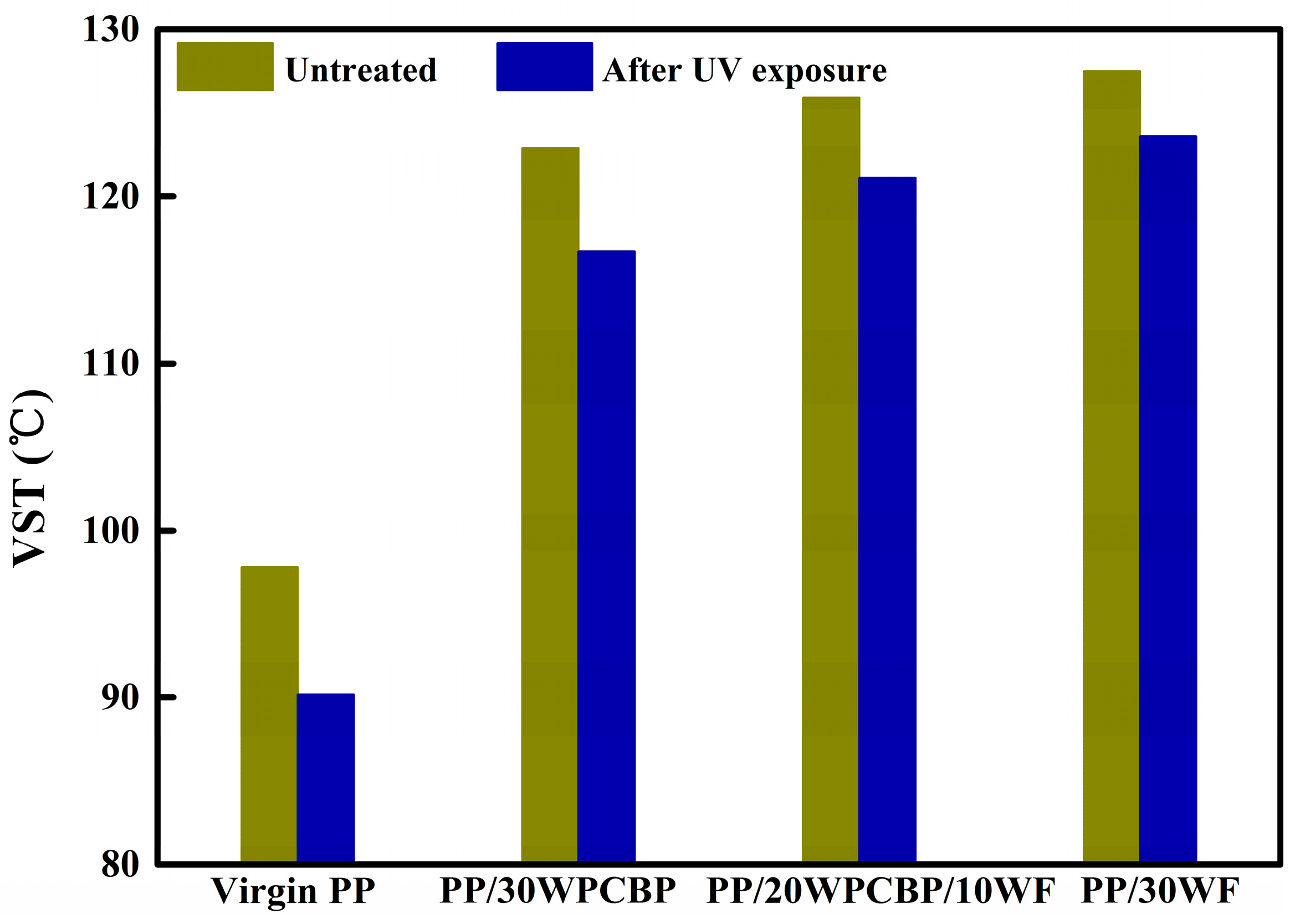
| Sample | Composition (wt. %) | |||
|---|---|---|---|---|
| PP | WPCBP | WF | PP-g-MAH | |
| Virgin PP | 100 | 0 | 0 | 0 |
| PP/30WPCBP | 64 | 30 | 0 | 6 |
| PP/20WPCBP/10WF | 64 | 20 | 10 | 6 |
| PP/15WPCBP/15WF | 64 | 15 | 15 | 6 |
| PP/10WPCBP/20WF | 64 | 10 | 20 | 6 |
| PP/30WF | 64 | 0 | 30 | 6 |
| Sample | OIT (min) | ||||
|---|---|---|---|---|---|
| 190 °C | 200 °C | 210 °C | 220 °C | 230 °C | |
| PP/30WPCBP | 2.7 | 1.2 | 0.7 | 0.5 | 0.2 |
| PP/20WPCBP/10WF | 2.9 | 1.5 | 0.8 | 0.6 | 0.3 |
| PP/30WF | 15.4 | 8.0 | 4.3 | 3.2 | 2.1 |
| Sample | Activation Energy E = 2.303RA | |
|---|---|---|
| PP/30WPCBP | 113.3 | |
| PP/20WPCBP/10WF | 103.3 | |
| PP/30WF | 95.2 |
| Sample | Retention Rate (%) | |
|---|---|---|
| Tensile Strength | Notched Impact Strength | |
| Virgin PP | 70.6 | 59.6 |
| PP/30WPCBP | 92.1 | 77.1 |
| PP/20WPCBP/10WF | 90.4 | 84.1 |
| PP/30WF | 96.8 | 95.7 |
| Sample | A2912 | A1715 | CI | |||
|---|---|---|---|---|---|---|
| Before | After | Before | After | Before | After | |
| Virgin PP | 6.76 | 6.44 | 0 | 0.02 | 0 | 0.28 |
| PP/30WPCBP | 27.22 | 13.85 | 0.20 | 1.16 | 0.07 | 8.4 |
| PP/20WPCBP/10WF | 44.16 | 6.79 | 0.38 | 0.32 | 0.86 | 4.68 |
| PP/30WF | 21.02 | 28.16 | 0.13 | 0.34 | 0.62 | 1.2 |
| Sample | Tp (°C) | Tm (°C) | Tm − Tp (°C) | Xc (%) | ||||
|---|---|---|---|---|---|---|---|---|
| Before | After | Before | After | Before | After | Before | After | |
| Virgin PP | 115.6 | 112.5 | 164.7 | 162.6 | 49.1 | 50.1 | 44.9 | 43.8 |
| PP/30WPCBP | 121.0 | 119.3 | 163.8 | 162.4 | 42.8 | 43.1 | 51.3 | 46.4 |
| PP/20WPCBP/10WF | 122.9 | 121.6 | 163.5 | 162.9 | 40.6 | 41.3 | 52.3 | 48.6 |
| PP/30WF | 124.6 | 123.1 | 163.6 | 162.8 | 39 | 39.7 | 55.2 | 53.2 |
© 2019 by the authors. Licensee MDPI, Basel, Switzerland. This article is an open access article distributed under the terms and conditions of the Creative Commons Attribution (CC BY) license (http://creativecommons.org/licenses/by/4.0/).
Share and Cite
Tian, S.; Luo, Y.; Chen, J.; He, H.; Chen, Y.; Ling, Z. A Comprehensive Study on The Accelerated Weathering Properties of Polypropylene—Wood Composites with Non-Metallic Materials of Waste-Printed Circuit Board Powders. Materials 2019, 12, 876. https://doi.org/10.3390/ma12060876
Tian S, Luo Y, Chen J, He H, Chen Y, Ling Z. A Comprehensive Study on The Accelerated Weathering Properties of Polypropylene—Wood Composites with Non-Metallic Materials of Waste-Printed Circuit Board Powders. Materials. 2019; 12(6):876. https://doi.org/10.3390/ma12060876
Chicago/Turabian StyleTian, Shenghui, Yuanfang Luo, Jizun Chen, Hui He, Yong Chen, and Zhang Ling. 2019. "A Comprehensive Study on The Accelerated Weathering Properties of Polypropylene—Wood Composites with Non-Metallic Materials of Waste-Printed Circuit Board Powders" Materials 12, no. 6: 876. https://doi.org/10.3390/ma12060876
APA StyleTian, S., Luo, Y., Chen, J., He, H., Chen, Y., & Ling, Z. (2019). A Comprehensive Study on The Accelerated Weathering Properties of Polypropylene—Wood Composites with Non-Metallic Materials of Waste-Printed Circuit Board Powders. Materials, 12(6), 876. https://doi.org/10.3390/ma12060876





